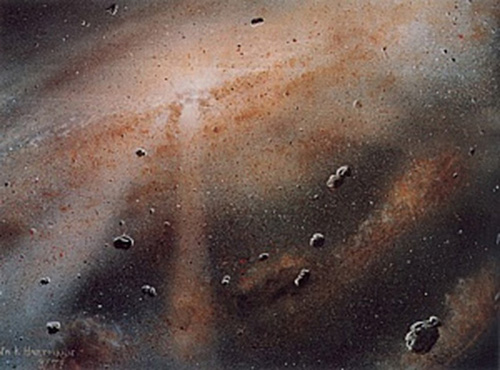How Was Saturn Formed?
There are two theories as to how planets in the solar system were created. The first and most widely accepted, core accretion, works well with the formation of the terrestrial planets but has problems with giant planets such as Saturn. The second, the disk instability method, may account for the creation of giant planets.

The core accretion model
Approximately 4.6 billion years ago, the solar system was a cloud of dust and gas known as a solar nebula. Gravity collapsed the material in on itself as it began to spin, forming the sun in the center of the nebula.
With the rise of the sun, the remaining material began to clump together. Small particles drew together, bound by the force of gravity, into larger particles. The solar wind swept away lighter elements, such as hydrogen and helium, from the closer regions, leaving only heavy, rocky materials to create terrestrial worlds. But farther away, the solar winds had less impact on lighter elements, allowing them to coalesce into gas giants such as Saturn. In this way, asteroids, comets, planets, and moons were created.
The composition of Saturn is almost completely the light gas hydrogen, with a significant part of it also composed of helium. Small traces of other elements exist in Saturn's atmosphere, as well. In order to capture these gases, Saturn needed to form its massive core quickly. The massive core could then gravitationally capture the lighter elements before solar winds swept them away.
The disk instability model
But the need for a rapid formation for the giant gas planets is one of the problems of core accretion. According to models, the process takes several million years, longer than the light gases were available in the early solar system. At the same time, the core accretion model faces a migration issue, as the baby planets are likely to spiral into the sun in a short amount of time.
According to a relatively new theory, disk instability, clumps of dust and gas are bound together early in the life of the solar system. Over time, these clumps slowly compact into a giant planet. These planets can form faster than their core accretion rivals, sometimes in as little as a thousand years, allowing them to trap the rapidly-vanishing lighter gases. They also quickly reach an orbit-stabilizing mass that keeps them from death-marching into the sun.
As scientists continue to study planets inside of the solar system, as well as around other stars, they will better understand how Saturn and its siblings formed.
— Nola Taylor Redd, SPACE.com Contributor
Related:
Join our Space Forums to keep talking space on the latest missions, night sky and more! And if you have a news tip, correction or comment, let us know at: community@space.com.
Get the Space.com Newsletter
Breaking space news, the latest updates on rocket launches, skywatching events and more!

Nola Taylor Tillman is a contributing writer for Space.com. She loves all things space and astronomy-related, and enjoys the opportunity to learn more. She has a Bachelor’s degree in English and Astrophysics from Agnes Scott college and served as an intern at Sky & Telescope magazine. In her free time, she homeschools her four children. Follow her on Twitter at @NolaTRedd










